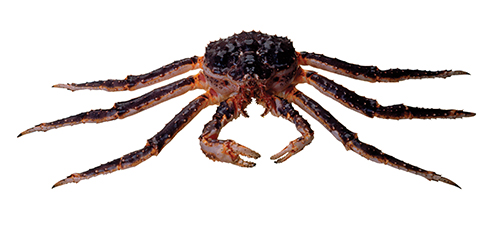
Shellfish fresh

Scallops
The sea is a trove of hidden treasures, of which perhaps Norwegian Scallops are the finest of all.
The striking, fan-shaped shell of the Norwegian Scallop is beautiful to behold. And not only this; when you open it, you have in your hand the sea’s greatest pearl. The large, creamy-white muscle is instantly recognisable. There is sweetness to it, combined with a mild lobster-like shellfish taste and a touch of ocean freshness that makes the Norwegian Scallop irresistible. They can be eaten raw, lightly steamed, fried or au gratin, and they are particularlyappetising when served in their decorative shells.

King Crab
As a result of Norway`s clear, cold waters, Norwegian Red King Crab is distinguished by freshness of taste, firmness of meat and a natural red colour, the fact that the crabs are caught in limited numbers and have only a short distance to travel to reach the receiving facilities results in Norwegian red King Crab of unique and high quality. The Norwegian King Crab is an impressive sight and counts among the most exquisite shellfish dishes you can serve. The king crab meat is so naturally tasty that the claws can be cooked and served as they are. However, crab meat can also be served in many different ways and is ideal when fried, barbecue or basked together with spices and other flavouring.

Blue Mussel
The flavor of steamed mussels is reason enough to enjoy the delicacy of the sea. If you need one more: A pound provides a third of daily needs for iron.
You find Blue mussels at 0 to 10 meters depth along the Norwegian coast. They feed on phytoplankton. Mussels spawn usually between April and June, when the water temperature is between eight and ten degrees. The fertilized eggs develop into larvae that swim freely for about a month until they attach themselves to surfaces of rocks, cliffs, boats and moorings.
Size up to 10-15 cm, and longevity; 20 years or more.

Brown Crab
The brown crab lives along the Norwegian coast as far north as Troms County. It is most common at depths up to 50 m. The female crab has a broader apron than the male, whereas the male has a flatter carapace and larger claws. Normally, brown crabs spawn in the autumn after they have reached maturity at the age of roughly five years. The female crab carries the eggs around in her abdominal apron throughout the winter until they hatch in the summer. The crab larvae are pelagic, i.e. they swim around in the water for the first 4-6 weeks of their lives, before descending to the sea floor.